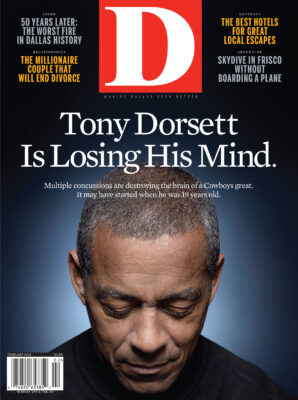Sometimes Larry James feels like the conversations never change. Twenty years ago, he became executive director of Central Dallas Ministries, a faith-based, inner-city nonprofit that tried to find smart, new ways to feed and house the poor. Then, about 17 percent of Dallasites lived below the poverty line. But whenever he wanted to put a community development or housing program in a middle-class neighborhood, people there accused him of trying to ghettoize their community. Eventually James gave up and concentrated on downtown and poor southern neighborhoods.
Two decades later. James is president and CEO of the development organization, which was renamed CitySquare. Now, about 23 percent of Dallasites live in poverty. But downtown is developing rapidly, up from 200 residents in 1995 to more than 8,000 today. Within that landscape, James’ permanent supportive housing project, CityWalk@Akard, has overcome myriad problems and is finally running well despite the expected challenges that come with transitioning formerly homeless people into an apartment community.
But he is still having that same conversation. Recently, for example, James was talking to a North Dallas real estate guy—kind, well-meaning, thoughtful—about the latest Dallas housing scandal. After a four-year investigation, the U.S. Department of Housing and Urban Development has issued a report accusing city officials of misusing federal housing funds in a way that caused racial segregation between northern and southern Dallas. The project that spurred the HUD inquiry was a redo of the old LTV Tower. The two original developers sued the city when their proposal for the building—590 apartments, at least 236 for low-income residents—was rejected.
James expressed to his real estate friend his frustration that there is still a bias against affordable housing. His friend looked at him, incredulous, and said, “But downtown is doing so well. Don’t you want it to flourish?”
This is the attitude James has been fighting: that low-income (and permanent supportive and affordable) housing destroys communities. It’s why he wrote a book, The Wealth of the Poor: How Valuing Every Neighbor Restores Hope in Our Cities, to combat that myth. But he knows these debates seem inconsequential to folks in North and East Dallas. They don’t see low-income housing as vital to a community’s health, they have the political power to keep it out of their neighborhoods, and therefore see it as someone else’s problem.
This HUD investigation just might change all that. There are three good reasons why you should take note of the “scandal”: one, it’s about issues that affect the rejuvenation of downtown by bringing the right sort of density to its streets. This is critical to the region’s continued growth. Two, it’s going to cause our city leaders to re-examine our entire city’s housing policy. And, three, if federal money dries up because of HUD’s findings—unlikely, but possible—then North Dallas is going to get more public-assistance housing whether it wants it or not.
Let’s first quickly deal with the HUD report accusing Dallas of misusing federal funds and promoting segregation. These allegations strike me as highly questionable, particularly that the LTV Tower developers were passed over as part of some orchestrated scheme. Everyone I talked to—developers, city officials past and present, advocates for the homeless, affordable-housing experts—had doubts about whether the spurned developers had enough low-income-project experience and whether they could pull together the financing. The developers have suggested those concerns were bunk and are part of a smear campaign. Is that possible? Sure. But I don’t think so. As one longtime low-income-housing-finance guy told me on background, “I wish I’d had enough foresight to ask for four times the money anyone else has ever gotten for one of these projects and then sue when I didn’t get picked.”
Why did HUD agree with the spurned developers, then? It’s complicated. The truth is the investigation might have turned up shenanigans. No one I talked to puts much stock in it, but maybe they’re underselling the problem. I will say, however, that the math HUD uses to show segregation does look suspect. When you say that downtown is segregated and your data set is 89 people, I raise an eyebrow.
Those are the trees. Let’s look at the forest. There is no racist agenda against affordable housing at City Hall. In fact, all the low-income housing advocates I talked to said they dearly miss the former director of the city’s housing department, the person who was in charge during the period that HUD investigated.
But the HUD accusations will most likely cause Dallas to rethink its housing policy. A few weeks after the report, Mayor Mike Rawlings (the city’s former homeless czar) said as much. “We are in desperate need of a strategy when it comes to housing, especially as it relates to southern Dallas,” Rawlings said. “We must work to ensure we are partnering with the right people and building the right units in the right places.”
Sounds good. But the reason we haven’t had a strategy isn’t for lack of trying. The mayor, in fact, once asked a leading homeless advocate for his long-term housing strategy for Dallas, so long as it “fit on the back of a napkin.” Which only works if your napkin is the size of a beach towel.
But let’s assume the best minds in our city begin to work on a serious, comprehensive housing strategy. What might that look like, and how might it affect you? We should look to the example provided by the mix of affordable and market-rate housing at Lone Star Gas Lofts and apply it to the city at large. That is: there need to be affordable apartments for the low-income workers who have jobs downtown. Such affordable housing promotes not just economic and racial diversity, but it also heightens the quality most important to downtown: density.
Most people who live downtown, people like me, belong to a community of self-selected urban liberals who understand and appreciate this approach. But there are other interests downtown that fight against “too much” housing. Churches with day cares, for example, one of which scuttled just such a housing development on St. Paul Street. And businesses. And folks who contribute millions to high-dollar Arts District projects. And so forth.
All of which leads City Councilman Philip Kingston to ask some basic questions about what sort of housing policy we want as a city. He never feels like he can get good answers. “People tell me we need more affordable housing to create a more vibrant downtown, like big cities have,” he says. “Really? London? New York? San Francisco? They have affordable housing? I’m obviously for good, smart housing solutions, but I think we really need to ask ourselves as a city what we want to do going forward, regardless of the merits of this HUD finding.”
What he’ll find, when he researches it, is that these cities do have low-income solutions similar to Dallas’, though fewer per capita. But back to his hypothetical questions: “Do we want to tie ourselves to federal money? Most of our housing money comes from there. If not, fine, but taxpayers have to pay. Do we want that? And where do we want these projects to be? Should the whole city take on their share? Should North Dallas and East Dallas? If they’re really economic drivers, why shouldn’t they be there, too?”
According to my low-income-housing-finance guy, if we can’t figure out a sound housing strategy, HUD will do it for us. “If we don’t put affordable housing downtown, then HUD is going to make us put it in North Dallas,” he says. “Downtown is the one affluent area in the city really set up to integrate different income levels cheek by jowl. For example, monthly rents in Lone Star Gas Lofts will range from $332 to $4,853. [And] downtown residents are okay with that.”
Question: Will North Dallas be okay with it?






